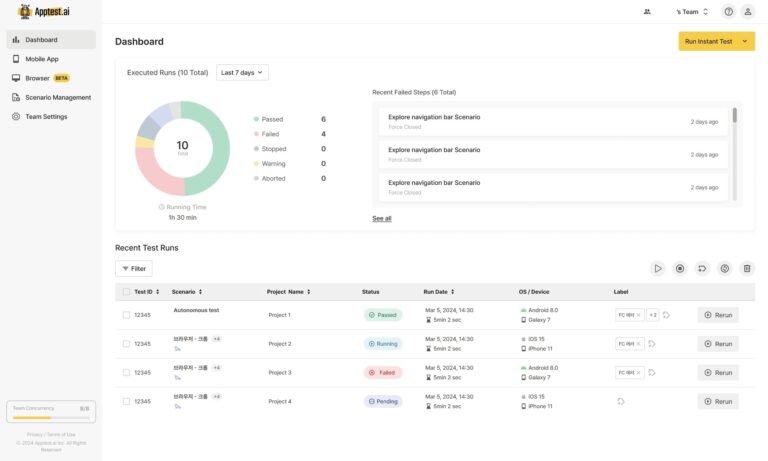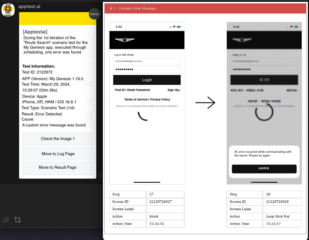
AI-Powered Test Automation Cloud
Ptero (pronounced 'Tero') is a comprehensive test automation cloud solution that integrates a Web Client, AI Testbot (Test Engine and AI Engine), and a Device Farm. Ptero streamlines testing workflows, enhances quality assurance, and supports autonomous UI-based exploratory and scenario testing. With Ptero, you can manage all your testing tasks efficiently on a single platform, ensuring robust, reliable results every time.

100% Coverage with Two Methods
Overview of Our Testing Services
Apptest.ai supports UI-based black-box testing to verify app functionality from the user’s perspective.
Autonomous Exploratory Test
AI Testbot autonomously explores the app to identify stability-related issues through non-functional black-box testing.
-
Automated UI Testing
-
Stability Verification
-
ZERO Maintenance Overhead
Scenario Test
This UI functional testing uses scenarios created with Stego to test the app's features and functionalities.
-
Functional Automation
-
Easy Scenario Management
-
Cost and Time Efficiency
AI Engine + Test Engine
AI Testbot
The AI Testbot leverages deep learning technologies like Object Detection (OD) and Optical Character Recognition (OCR) to analyze app screens. It automatically generates and executes test scenarios, enabling automated testing without manual test case creation, ensuring thorough validation of app stability and functionality.
Easy and Intuitive
Web Client
Our web client offers an intuitive interface that provides a comprehensive view of all test results. Easily monitor test progress, successes, failures, and detailed error information with clear visual charts and graphs, allowing for quick analysis and efficient test management.
Real Devices
Device Farm
Apptest.ai's Device Farm allows testing on a wide range of real devices without the need for physical hardware. With the option to deploy on-premises, customers can securely manage their testing environments, optimizing test coverage and efficiency to fit their specific needs.
-
Provides error tracking, performance insights, and easy result
Premium Test Report -
Real-time Error Alerts
Error Notification Service

The premium report service provides performance improvement guidance based on CPU and network profiling, alongside detecting errors like Force Close (FC) and Application Not Responding (ANR). It meticulously records the paths of detected errors and visualizes the application's structure during testing, using a screen flow format with screenshots, device logs, and captures. Additionally, users can create shareable links for test results, enabling easier external communication. These detailed reporting features assist developers and QA teams in swiftly identifying and resolving issues, improving overall application performance and stability.

The error notification service quickly communicates any errors discovered after testing is completed. This service provides error information through notification systems set by the user. For example, error notifications can be received via various channels such as messengers, collaboration tools, or email. This immediate alert feature allows developers and QA teams to recognize and respond to issues promptly. Moreover, receiving real-time error notifications shortens problem resolution times and enables more efficient management of the development cycle.

The premium report service provides performance improvement guidance based on CPU and network profiling, alongside detecting errors like Force Close (FC) and Application Not Responding (ANR). It meticulously records the paths of detected errors and visualizes the application’s structure during testing, using a screen flow format with screenshots, device logs, and captures. Additionally, users can create shareable links for test results, enabling easier external communication. These detailed reporting features assist developers and QA teams in swiftly identifying and resolving issues, improving overall application performance and stability.

The error notification service quickly communicates any errors discovered after testing is completed. This service provides error information through notification systems set by the user. For example, error notifications can be received via various channels such as messengers, collaboration tools, or email. This immediate alert feature allows developers and QA teams to recognize and respond to issues promptly. Moreover, receiving real-time error notifications shortens problem resolution times and enables more efficient management of the development cycle.